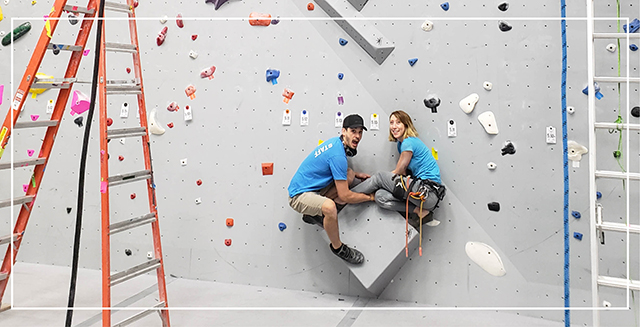Route Setter Beta

Am I doing this right?
by: Joe Stangel
It’s a word you will hear all the time when you’re hanging out with climbers – beta.
The word comes from a long time ago; in a galaxy far, far away. It references a time when climbers used to film their climbs on beta max tapes. People would ask each other for the beta tape of certain climbs to figure out how they did the climb. Nowadays, the word is thrown around everyday by climbers big and small. What is beta? What’s the beta? What’s your beta? There is often a big difference between those questions.
Beta is a shorthand way to reference the sequence of movements that someone used to climb their way through a route or problem. It can apply to an entire climb or even a single, specific move. As route setters it’s our job to create sequences that appropriately challenge climbers of all skill levels. A 5.12 climber has a different bag of tricks and tools of the trade than the ones a 5.10 climber does. Experienced climbers know how to use body positioning to solve more complex sequences rather than just relying on pure strength. One of our goals as route setters is to teach these more complex sequences to less experienced climbers. By positioning and ordering hand and foot holds just right, it’s possible to lead people into unique and different body positions. This is often what is called the intended beta. Our objective is to make sure that the intended beta is appropriate for the grade and to be the easiest way to complete the climb. But, it may not be the simplest or most obvious way. For newer climbers this is where the beta is often ‘broken’.
In a climbing gym, route setters have nearly complete control of what hand holds and foot holds a climber can use. Because of this we have more control of the consistency of grades, both in relation to climbs of the same grade and climbs of the grades directly above and below that one. This leads to situations you won’t see outdoors. The most obvious example of this is foot holds on easier climbs (think 5.5 to 5.10-). At Edgeworks, the feet on these climbs are often nearly as big as the hands, only less incut and positive. Often they are sloped or flat. The goal is for them to be not as nice to grab onto than the nice, positive jug right next to it. This is how we ‘force’ sequences on the lower grades. This is often also where people create the habit of grabbing whatever they can and muscling their way to the top. After a few months, hand strength increases and climbers start to feel more comfortable using smaller edges and crimps. Next, those climbs that ask for more technique to get to the top become a little easier to get, think 5.10- to 5.10+.
This is when grabbing and pulling isn’t always the easiest way to do a sequence. This is where the route setters are trying to teach climbers the different capabilities of their bodies. This is where we are trying to lead you into doing something a little different. It might feel insecure or awkward or require you to do something you haven’t before, but it should feel ‘right’. It should also make you want to naturally move through the sequence. Once you are used to it, it should feel easy. Easier than grabbing on that tiny, sharp foot chip, stepping up and getting fully stretched out to grab then next good hold. Which oftentimes will put your hands out of sequence for the next move. So a clumsy hand match on an obviously single handed hold is required to keep moving. I don’t know about anyone else but that doesn’t sound like a fun climb to me. Just because you can reach something doesn’t mean you should.
These types of situations are when we see the most complaints about a route or problem being reachy, awkward, hard for the grade or just bad. It’s tough to hear and deal with. Not because it’s a negative review of our work, but because there’s no easy way for us to address it. We can’t offer the beta. We can’t help or talk you through the difficulties. We can’t offer little tips or tricks. We can only set the challenge and then hope climbers will accept it and be open to learning new ways to work through the tough spots.
Modern climbing isn’t about just getting to the top, it’s about the journey you take to get there. Route setters create a maze, a puzzle for your body and mind, and we are rooting for you to get to the other end.



